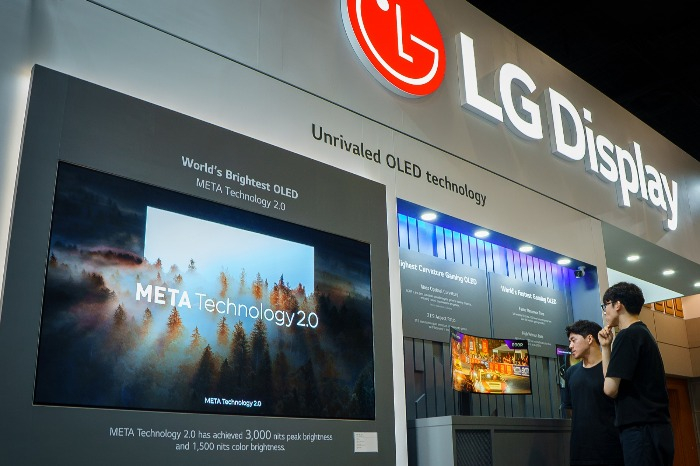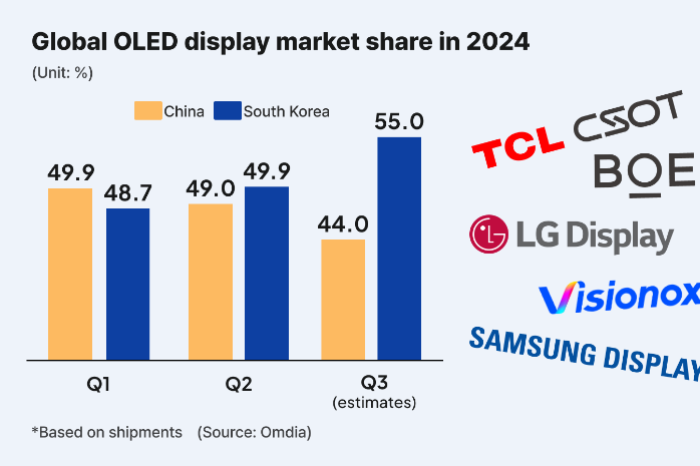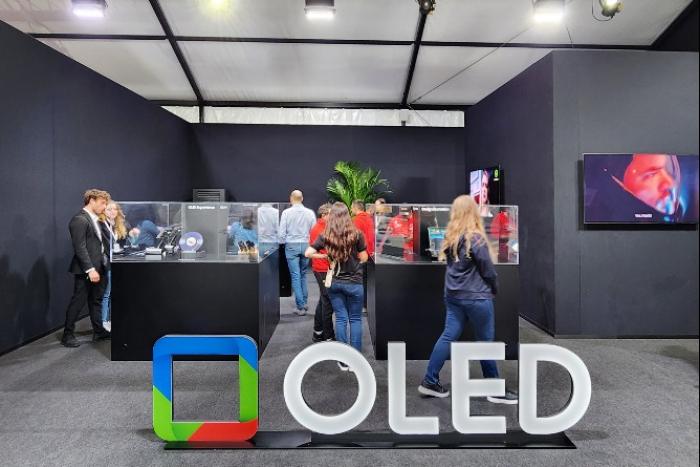Korean displays regain top spot with premium information tech OLEDs
LG Display and Samsung Display are set to widen the technology gap with Chinese rivals through next-generation OLEDs
By Dec 05, 2024 (Gmt+09:00)
LG Chem to sell water filter business to Glenwood PE for $692 million


KT&G eyes overseas M&A after rejecting activist fund's offer


Mirae Asset to be named Korea Post’s core real estate fund operator


StockX in merger talks with Naver’s online reseller Kream


Meritz backs half of ex-manager’s $210 mn hedge fund



South Korean display makers regained ground in the global organic light-emitting diode (OLED) panel market in the second quarter, elbowing out the previous quarter’s No. 1 Chinese rivals thanks to brisk sales of high-end OLED displays for information technology (IT) devices.
According to global technology research firm Omdia, Samsung Display Co. and LG Display Co. jointly commanded the largest 49.9% share of global OLED panel shipments in the April-June period, beating Chinese players’ 49.0%.
The result comes a quarter after Chinese display makers snatched the crown from multiyear OLED leader Korean display giants for the first time. In the first quarter, Korean OLED panel shipments accounted for 48.7%, trailing Chinese shipments' 49.9%.
Korean display makers’ comeback was driven by the robust sales of IT OLED panels, especially for premium tablet PCs. Samsung Display and LG Display supplied all the OLED screens for Apple Inc.'s iPad Pro series, which launched in May.

They are forecast to have further widened the shipment gap in the third quarter thanks to the release of the iPhone 16 series. The Korean display duo supplied most of the OLED panels for the new iPhone series.
Omdia projected the combined share of Samsung Display and LG Display in OLED panel shipments would grow to about 55% in the third quarter.
RAZOR-THIN GAP WITH CHINESE PLAYERS
But Chinese OLED panel makers are poised to overtake their Korean rivals again soon, as their local IT companies have recently ramped up smartphone shipments.
A majority of smartphones by Chinese brands such as Huawei, Xiaomi, Oppo and Vivo are fitted with OLED displays supplied by BOE, CSOT and other Chinese display makers.
According to the Korea Display Industry Association, Chinese smartphones’ employment of Korean OLED panels plunged to 16% in 2023 from 79% in 2021.

Chinese OLED panels have also significantly narrowed the technological gap with their Korean counterparts partly due to the Chinese government’s generous aid to foster the country’s OLED industry.
Beijing has designated OLED as one of the national future growth engines and has been pouring massive investment into developing the country’s OLED technology. It has also actively sought to encourage investment in the country’s OLED industry by offering subsidies and tax breaks.
This strategy resembles the colossal investments by the world’s second-largest economy to nurture the nation’s liquid crystal display (LCD) industry, which is now the world’s No. 1 after beating Korean LCDs.
NEXT-GENERATION OLED TECHNOLOGY
In the face of growing threats from Chinese OLED displays, Samsung Display and LG Display will strive to widen the technology gap with Chinese rivals with next-generation OLED technology, such as OLED panels powered by adaptive frequency technology for low power consumption and sunlight-readable, or high-brightness, panels.

They will focus on the development of tandem OLED that uses multiple light-emitting layers to increase brightness, efficiency and longevity, as well as low-temperature polycrystalline oxide (LTPO) thin film transistor (TFT) technology, mainly used in the iPhone Pro series and premium IT devices.
Together Samsung Display and LG Display controlled 72.5% of global LTPO OLED sales in the second quarter.
With the next-generation OLED technology, Korean display makers will accelerate their penetration in the IT OLED panel market.
Samsung Display has invested 4.1 trillion won ($2.9 billion) to build Gen 8.6 IT OLED panel lines in Asan, South Chungcheong Province, at home to begin mass production in 2026.
It will invest $1.8 billion to build an OLED line in Vietnam for small- to medium-sized panels used in laptops and tablets, the company announced in September.
In November, LG Display also decided to invest an additional $1 billion in its existing OLED panel fab in Haiphong, Vietnam.
Write to Chae-Yeon Kim at why29@hankyung.com
Sookyung Seo edited this article.
-
 ElectronicsLG Display to invest extra $1 bn in Vietnam OLED plant
ElectronicsLG Display to invest extra $1 bn in Vietnam OLED plantNov 17, 2024 (Gmt+09:00)
1 Min read -
 ElectronicsSamsung Display to build $1.8 billion OLED plant in Vietnam
ElectronicsSamsung Display to build $1.8 billion OLED plant in VietnamSep 24, 2024 (Gmt+09:00)
3 Min read -
 ElectronicsGloves off for Samsung, LG in high-end OLED display fight
ElectronicsGloves off for Samsung, LG in high-end OLED display fightAug 29, 2024 (Gmt+09:00)
3 Min read -
 ElectronicsLG Display seeks to supply tandem OLED display to Bentley, Cadillac
ElectronicsLG Display seeks to supply tandem OLED display to Bentley, CadillacAug 14, 2024 (Gmt+09:00)
3 Min read -
 ElectronicsLG Display bets big on Tandem OLED in AI computing era
ElectronicsLG Display bets big on Tandem OLED in AI computing eraJun 24, 2024 (Gmt+09:00)
1 Min read -
 ElectronicsSamsung Display records 1 mn cumulative shipments of QD-OLED monitors
ElectronicsSamsung Display records 1 mn cumulative shipments of QD-OLED monitorsMay 23, 2024 (Gmt+09:00)
1 Min read -
 ElectronicsSamsung ups smaller OLED workforce to fend off Chinese rivals
ElectronicsSamsung ups smaller OLED workforce to fend off Chinese rivalsApr 04, 2024 (Gmt+09:00)
4 Min read


